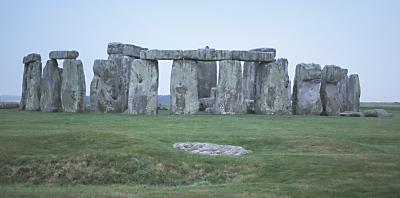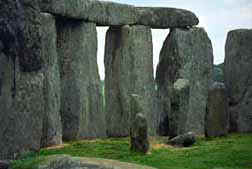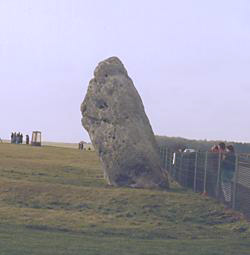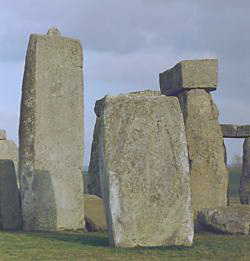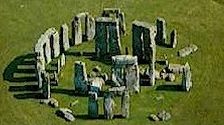|
STONEHENGE
|
|
HOME | BIOLOGY | FILMS | GEOGRAPHY | HISTORY | INDEX | INVESTORS | MUSIC | SOLAR BOATS | SPORT |
|
Stonehenge is the most important prehistoric monument in Britain. It consists of earth, timber, and stone structures. Stonehenge dates from 3100-2300 B.C. The purpose of Stonehenge has many theories - temple for sun worship (a druid temple) a burial ground, an astronomical calendar ? Some of the stones were deliberately transported there with considerable effort from a great distance away - a truly remarkable achievement. The great stone circles and horseshoe arrangements for which Stonehenge is famous are later additions to the monument. Stonehenge is situated at the junction of the A303 and the A344, just west of Amesbury in Wiltshire. There is a large car park and rather awful "visitor centre" on the north side of the A344. There is a charge to gain access to the site (around £4 last time I was there).
Stonehenge is surely Britain's greatest national icon, symbolizing mystery, power and endurance. Its original purpose is unclear to us, but some have speculated that it was a temple made for the worship of ancient earth deities. It has been called an astronomical observatory for marking significant events on the prehistoric calendar. Others claim that it was a sacred site for the burial of high-ranking citizens from the societies of long ago. While we can't say with any
degree of certainty what it was for, we can say that it
wasn't constructed for any casual purpose. Only
something very important to the ancients would have been
worth the effort and investment that it took to
construct Stonehenge.
About 2,000 BC, the first stone circle (which is now the inner circle), comprised of small bluestones, was set up, but abandoned before completion. The stones used in that first circle are believed to be from the Prescelly Mountains, located roughly 240 miles away, at the southwestern tip of Wales. The bluestones weigh up to 4 tons each and about 80 stones were used, in all. Given the distance they had to travel, this presented quite a transportation problem.
Once
on site, a sarsen stone was prepared to accommodate
stone lintels along its top surface. It was then dragged
until the end was over the opening of the hole. Great
levers were inserted under the stone and it was raised
until gravity made it slide into the hole. At this
point, the stone stood on about a 30° angle from the
ground. Ropes were attached to the top and teams of men
pulled from the other side to raise it into the full
upright position. It was secured by filling the hole at
its base with small, round packing stones. At this
point, the lintels were lowered into place and secured
vertically by mortice and tenon joints and horizontally
by tongue and groove joints. Stonehenge was probably
finally completed around 1500 BC.
The stones were located on "Mount Killaraus"
and were used as a site for performing rituals and for
healing. Led by King Uther and Merlin, the expedition
arrived at the spot in Ireland. The Britons, none of
whom were giants, apparently, were unsuccessful in their
attempts to move the great stones. At this point, Merlin
realized that only his magic arts would turn the trick.
So, they were dismantled and shipped back to Britain
where they were set up (see illus. at right) as they had
been before, in a great circle, around the mass grave of
the murdered noblemen. The story goes on to tell that
Aurelius, Uther and Arthur's successor, Constantine were
also buried there in their time*.
Stonehenge Phase I
The oldest structures on the site of Stonehenge are the bank, ditch and the pits known as the Aubrey Holes which were dug just within the circumference of the ditch. These are thought to have been constructed around 3,100 BC. The ditch and bank are what make the "henge" at Stonehenge.
A common mistake is to refer to any stone circle site as a henge. A henge is an earthwork monument constructed in Neolithic Britain. Some henges might have contained timber posts or settings of stones at the centre, but by no means did they all. There is no available evidence for timber or stone having been erected at the centre of Stonehenge during this phase due to the amount of damage caused at the site by people digging for "treasure" in the centre. The henge at Stonehenge is unusual in that the bank is set within the ditch, usually the bank is on the outside of the ditch (as at Avebury for example). The ditch has become filled in over the years, and the bank has been worn down. Originally the ditch would have been around 2 metres deep and the bank around the same in height. The henge is around 120 metres in diameter. An entrance in the northeast section of the bank and ditch points towards the direction of the midsummer sunrise.
The 56 Aubrey Holes are named after the 17th Century antiquarian, John Aubrey, who first described these features. The pits are around a metre in diameter and the same in depth. Modern visitors can see the sites of the Aubrey Holes marked in cement around the inside edge of the ditch. It seems that the holes were filled in with chalk rubble soon after they were dug and there is no evidence that either stones or timbers ever stood in these pits. Later, people buried cremated bone within the pits but there is no evidence that they were originally dug for this purpose.
Stonehenge Phase II
Around 2,100 BC the site was redesigned. The so called "bluestones" were brought to Stonehenge and the construction of a double circle of these stones was started at the centre of the henge. The bluestones are so called because when freshly broken or wetted the stone is quite blue in colour. The geological name for this stone is spotted dolerite.
The bluestones are a point of some controversy at Stonehenge. The stone is not local to the area and can only be found in the Preseli Mountains of South Wales. One theory is that the stones were brought to the area by glaciers. As glacial erratics the stones might have been revered by the local population, realising that they were unlike any other stones in the vicinity and thus were of special significance.
The other theory is that they were transported by people all the way from the Preseli Mountains especially for the purpose. Each stone weighs around 4 tonnes and the theory is that they were transported by land, sea and river to Salisbury plain. A recent attempt to explore this possibility ended in disaster when a raft carrying a stone sank in Milford Haven. However, I favour this explanation of the transportation of the bluestones. If they were glacial erratics then surely we would still be finding pieces of bluestone in the area, and I'm not aware of any evidence for a glacier running from southwest Wales to Salisbury Plain.
It is thought that during this period the Heel Stone was added to the site, marking the direction of the midsummer sunrise from the centre of the circle. There is evidence in the form of a second stone hole that there might have been a pair of Heel stones erected at this time. It might also be that the Heel Stone was moved from one stone hole to the other at some point.
Excavations at the site show that this second phase of construction was never actually completed. The double circle of bluestones at the centre of the henge was never finished. A dramatic new plan had been formulated for Stonehenge.
Stonehenge Phase III
Around 2,000 BC construction started on a large circle of sarsen stones all capped with lintels. This is the outer part of the structure that visitors see today. The lintels formed a continuous circle at a height of around 16 feet from the ground. The huge stones used to construct this circle were brought from the Marlborough Downs, around 20 miles north of Stonehenge. This is the same source of stone used for the construction of the circles at Avebury.
The transportation of stones up to 50 tonnes in weight, over a distance of 20 miles, is an incredible achievement. The most likely method for moving the stones is that they were tied on to wooden sledges and then pulled over a set of rollers.
Once at Stonehenge the sarsen stones were pounded into shape using stone hammers, some of which have been found on the site. Much thought went into the shaping of the stones. The uprights are gently tapered and the lintels are curved to fit into the circle. The lintels were not just dropped into place, joints were made. The top of each upright in the circle had two protrusions at the top which fitted into a cup carved at the end of each lintel, rather like a mortice and tenon joint in woodworking. Each lintel was also joined to its neighbour with a tongue and groove joint. These joints are more typical of woodworking than of masonry. Look closely at the top of the uprights at Stonehenge and you can still see the tenons.
One of the biggest debates about Stonehenge is just how the lintels were put into place on top of the uprights. One legend has the wizard Merlin levitating the stones in to position, others speak of giants lifting the stones. A more realistic theory is that wooden scaffolds were built around the uprights. The lintel was placed on the scaffold and was then gradually raised by levering the stone up and placing more timber underneath. Finally, when the scaffold and lintel reached the top of the upright stones the lintel could be levered into position.
Another idea is that a wooden ramp was built on one side of the uprights and the builders pulled the lintel up the ramp using ropes from the other side. Yet another theory is that once the upright stones were in place they were buried in earth. The lintel was then dragged up the earth mound and put into place. The earth would then be dug away leaving the lintel in place at the top. Personally I favour the scaffold theory mentioned above for raising the lintels into position.
Within the outer circle a horseshoe of 5 larger trilithons was erected. These stood separate from one another, unlike the great ring of trilithons surrounding them. A selection of the bluestones from phase II was stood in an oval within the trilithon horseshoe. Some of the bluestones were set up as trilithons, remains of the required joints can still be seen on some of the bluestones today.
Later, a double ring of stone holes was dug outside the great sarsen circle. These are known as the Y and Z holes. The intention seems to have been to stand the remaining bluestones in a double circle in these holes. However this project was abandoned.
Stonehenge Phase IV
Stonehenge was redesigned once more, around 1,500 BC. The oval setting of bluestones within the trilithon horseshoe was dismantled. Instead another horseshoe was erected using these stones within the U of trilithons, and the rest were set standing in a circle within the outer ring of sarsens. It is the ruins of this final structure that we can see today at Stonehenge.
Amesbury,
Salisbury,
Wiltshire
We are featuring a building of considerable historic interest in Sussex and presently a monument at risk as probably the last surviving early electricity generating station in the country. While not so grand or ancient as Stonehenge, nevertheless, this unimposing building represents the development of man during a phase of rapid advancement, almost lost to the nation, as English Heritage admit they were powerless to intervene.
Please use the links below to read the story of this unusual building in Lime Park, just outside the village of Herstmonceux. A non profit making charity has been formed to head up much needed restoration works.
Introduction | Instructions | ISBN | Batteries | Boiler Room | Floor Plan | Ron Saunders
Industrial Revolution | Lime Park | Machinery | Map | Power House | Argus 1999
Public Supply | Roof Construction | Rural Supply | Sussex Express 1913 | Conclusion
Archaeology South East | East Sussex CC | English Heritage | SIAS | Sx Exp 1999
Herstmonceux Electricity Generating Works Circa. 1900 - 1936 Links:
GENERAL HISTORY LINKS
MARITIME HISTORY
A taste for adventure capitalists
Solar Cola - a healthier alternative
|
|
This
website
is Copyright © 1999 & 2007 NJK. The bird |
|
AUTOMOTIVE | BLUEBIRD | ELECTRIC CARS | ELECTRIC CYCLES | SOLAR CARS |
